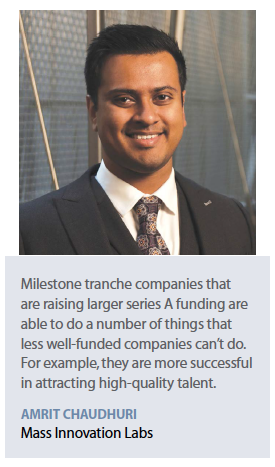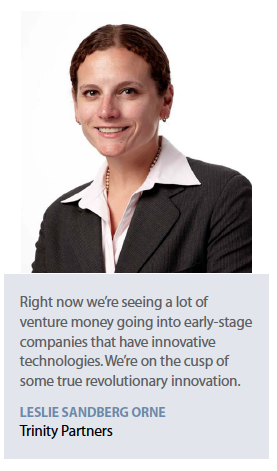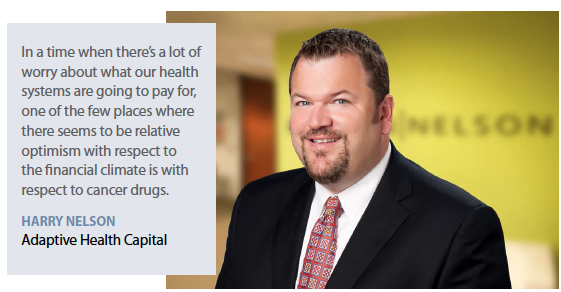Venture capital funding trends indicate a healthy environment for biopharma companies. The recent five-year trend has been very good with more dollars being deployed into venture-backed companies, many of which are R&D focused; there is more money available to biopharma companies compared with 10 years ago; and funding deals for early-stage companies seeking first round investments are larger than they used to be.
The most recent PwC/CB Insights Healthcare MoneyTree reports that 2017 annual funding reached $14.4 billion with 98 more deals than in 2016.
The current wave of venture capital funding is focused on supporting great science and innovation, and investors fully expect this trend to continue going forward.
 “Biotech companies have been a very productive area for public market venture capital," says Dennis Podlesak, partner at Domain. “And returns for our firm have been much stronger as a result. The top VC firms have all seen the benefits of drugs being approved by the FDA, biotech companies moving successfully into public markets, appreciating in value, and the fact that big pharma continues to acquire innovation from biotech companies. Venture-backed biotech companies continue to drive the innovation economy in the United States and around the world, and this trend will continue."
“Biotech companies have been a very productive area for public market venture capital," says Dennis Podlesak, partner at Domain. “And returns for our firm have been much stronger as a result. The top VC firms have all seen the benefits of drugs being approved by the FDA, biotech companies moving successfully into public markets, appreciating in value, and the fact that big pharma continues to acquire innovation from biotech companies. Venture-backed biotech companies continue to drive the innovation economy in the United States and around the world, and this trend will continue."
Early-stage companies with novel platform technologies are the biggest beneficiaries of the influx of funding.
“Right now we’re seeing a lot of venture money going into early-stage companies that have innovative technologies, whether that’s RNAi, DNA technologies, gene therapy, or CRISPR," says Leslie Sandberg Orne, a senior partner at Trinity Partners. “Venture trends in the past favored product-based companies, in other words, those companies with a product moving toward clinical trials that could potentially show later-stage evidence."
The hot therapeutic areas continue to be oncology and orphan diseases, with immunotherapy research and CAR T-cell therapies leading the way.
“We’ve seen advances in the therapies in both what the FDA is approving and what’s happening in the academic research centers around the United States," says Harry Nelson, co-chair of the investment committee, Adaptive Health Capital. “In a time when there’s a lot of worry about what our health system is going to pay for, one of the few places where there seems to be relative optimism with respect to the financial climate is cancer."
Some analysts say this is being driven by the technology and not by the indication. “We’re on the cusp of some truly revolutionary innovation," Ms. Orne says. “Pharmaceutical companies don’t know how to effectively bring these advances in house. They’re farming out all of their early-stage research and this is creating a community of small biotech companies that can take on the risk and that have the technology know-how. There’s so much brainpower in the biotech space right now."
Investors are cautious and selective in funding companies, says Izabela Ochocka, founder and president, BIMA Capital.
“We look for companies that can create long-term value as the biotech development cycles are very long," she says. “We are selectively choosing companies that offer unique treatments or groundbreaking discoveries such as advanced and novel treatments for cancer or Alzheimer’s disease."
 Cutting-edge science has always been appealing to investors, and this will continue to be the case, Ms. Ochocka says.
Cutting-edge science has always been appealing to investors, and this will continue to be the case, Ms. Ochocka says.
There is strong competition for good companies and good biology, says Martin Heidecker, Ph.D., director, investment manager, The Boehringer Ingelheim Venture Fund (BIVF).
“We will continue to see pharma companies hungry for new molecules and new drugs to fill their pipelines," he says.
The current funding environment is leading to company creation around interesting biology — autoimmunity, fibrosis, immuno-oncology — focusing on the cells in the immune system, Dr. Heidecker says.
“VC companies are willing to invest early in companies that are investigating the biology of those cells," he adds.
Frost & Sullivan expects cell and gene therapy to show strong potential, especially across the rare diseases segment. Large pharmaceutical/biotech companies such as Amgen, Sanofi, and Pfizer are investing in molecules in the early stages of clinical development. The global biologics market is expected to surpass $300 billion by 2022.
Longer term, Dr. Heidecker says investors also will be attracted to research in the areas of CNS and anti-aging.
Mr. Nelson says another hot area is that of digital health.
“We’re seeing a lot of a projects that are centered around health information technology, smartphone healthcare, etc., where the focus is to get consumers to use digital health tools," he says.
Behind the Numbers
Venture capital investment across all U.S. industries last year was $67 billion, according to Thomson Reuters. A PwC/CB Insights MoneyTree report covering all industries shows an even higher value: $71.9 billion across 5,052 deals, up 15% from 2016.
The Healthcare MoneyTree report finds while the number of deals from 2012 to 2017 has remained relatively consistent, the average deal size has steadily increased from $10 million in 2012 to $19.3 million in 2017.
There were 20 mega-rounds — deals of more than $100 million in value — in 2017.
Part of what is driving the increase in terms of the deal size is attributable to greater alignment taking place between biotech and big pharma.
Allergan, Mr. Podlesak says, is a good example of a big pharma company that has proactively done a superb job of strategically aligning itself with biotech and the venture community. To kick off the year, every January  at the J.P. Morgan Healthcare Conference, Allergan CEO Brent Saunders and his C-suite team hosts the who’s who of the venture community. Mr. Saunders and the Allergan team present a business update and, importantly, David Nicholson, the company’s chief R&D officer, presents the R&D portfolio and disease areas and targets Allergan may be interested in evaluating for collaboration. This process fosters alignment and productivity for both big pharma and the venture-backed community.
at the J.P. Morgan Healthcare Conference, Allergan CEO Brent Saunders and his C-suite team hosts the who’s who of the venture community. Mr. Saunders and the Allergan team present a business update and, importantly, David Nicholson, the company’s chief R&D officer, presents the R&D portfolio and disease areas and targets Allergan may be interested in evaluating for collaboration. This process fosters alignment and productivity for both big pharma and the venture-backed community.
“Pharma companies have changed their business models by cutting R&D spending, and as such are much more reliant on their relationships with the VC-funded biotech companies to acquire innovation," Mr. Podlesak says. “Biotech companies with best-in-class technologies have become increasingly good at building relationships and leveraging insights, knowledge, and drug company expertise with pharma companies and this has led to greater productivity in drug development."
Additionally, venture capitalists have changed how they approach funding of early-stage biopharma companies. The number of financing rounds has gone down, while the dollar amount of each round has gone up. The trend, experts say, is toward tranche investment, where money is typically invested over two or three milestones based on the progress of the company. The initial investments are larger, and are meant to provide a stable funding source for companies with promising technologies.
“In the early 2000s, many companies did really well," says Amrit Chaudhuri, CEO of Mass Innovation Labs. “But in 2008, the economic climate prevented many companies from moving forward because they weren’t able to raise series B funding. Many companies failed, not because their technology didn’t work but because their projects weren’t fundable at that time. VCs lost a lot of money because they hadn’t reserved enough capital or counted on having others come in and fund the series B."
The tranche model, he says, helps to fund a company through the critical stages of development, beyond the proof-of-concept stage and the first year and a half of maturation.
“We put forward a lot of restrictions and milestones to make sure that we’re not giving money to a company that isn’t performing," Mr. Chaudhuri says. “By doing so, this actually protects our assets and the funded company’s risks." He points to a few examples of successful companies that started with tranche investments, such as CRISPR Therapeutics, Editas Medicine, and Gritstone Oncology.
“Milestone tranche companies that are raising larger series A funding are able to do a number of things that less well-funded companies can’t do," he says. “For example, they are more successful in attracting high-quality talent. For many of these companies, the executive team and/or their boards are comprised of former pharmaceutical company executives."
Mr. Podlesak says one of the benefits for investors behind the tranched investing business model has been R&D productivity, particularly in oncology. Investors are targeting exceptionally attractive companies with great science and great management teams, and it is these companies that are getting disproportionately large tranched funding commitments early on.
“Oncology ranks No. 1 of all the therapeutic categories in terms of the highest return on investment over time, and companies in the oncology space have been the beneficiaries of the largest increases in R&D spending," he say. “The annual life-sciences R&D spend is somewhere in the $80 billion range, and oncology accounted for about 40% of that. In a recent McKinsey study conducted earlier this year, the study noted this percentage has doubled since 2000 and quadrupled since 1996."
 Another noteworthy trend, Mr. Podlesak says, is that many biotech companies are now developing multiple products in their pipeline, which obviously requires more capital than previous periods when many biotech companies were formed to develop just one product initially in their R&D pipeline.
Another noteworthy trend, Mr. Podlesak says, is that many biotech companies are now developing multiple products in their pipeline, which obviously requires more capital than previous periods when many biotech companies were formed to develop just one product initially in their R&D pipeline.
IPOs and M&As
The total volume and value of life-sciences industry M&A fell almost 20% in 2017, according to EY. Life-sciences M&A and divestitures during 2017 also featured a pronounced shift away from the typical epicenters of the biopharma sector and the United States. Biopharmaceutical acquisitions accounted for roughly only one-quarter of all M&A value, as compared with almost 80% in 2016.
EY predicts that larger companies this year will see an increasingly crowded field of smaller, high-growth competitors. Further, EY predicts the total value of life-sciences M&A should once again surpass $200 billion.
Ms. Orne says while the IPO window was at its highest in 2015, there is still a healthy market for both IPOs and M&As.
“We’re going to see M&A dominate as an exit strategy, because biopharma companies are outsourcing early R&D," she says. “There will be a land grab for some of these new technologies."
The largest IPO of the fourth quarter 2017 — Danali Therapeuticas — raised almost twice as much as the largest listing from the previous quarter, according to the Dow Jones Venture Capital report. Denali Therapeutics raised $250 million in its IPO, which valued the company at $1.7 billion. The company, which is developing a broad portfolio of therapeutic candidates for treating neurodegenerative diseases, was backed by investors, such as ARCH Venture Partners and FPrime Capital.
Because acquisitions have been happening earlier in the product lifecycle, median time from company founding to exit via M&A has decreased as well, from a high of 7.4 years in 2012 to just 4.4 years in 2015; median time over the whole 2010 to 2015 period was 6.2 years.
Mr. Nelson says there has been a lot of bargain hunting in the M&A arena.
“Smaller and middle-market investors are looking for attractive economics in terms of time to the next phase of the project and that there is confidence about the progress of the project in the market," he says.
Some pharmaceutical companies are taking a different approach to accessing new technologies. They are looking at innovation happening in the university world or in those small biotech companies that are close to universities, Dr. Heidecker says.
“The question that big pharma companies need to ask themselves is: When is the right time to participate in the innovation?" he asks. “We started our own pre-venture fund at BIVF and are investing early to get familiar with the innovative technologies coming from universities and small biotechs. We are a strategic corporate investor, and being strategic for us means that we invest in platform technologies outside of what Boehringer Ingelheim is focusing on. Our strategic objective is to create opportunities for our parent company."
BIVF’s strategy is to invest in the development of pioneering science — from idea to proof of concept — that offers the potential to provide significant benefits for patients and also for the company. Currently, about half of the companies that BIVF invests in are working on immuno-oncology.
“We started investing in immuno-oncology at a time when our parent company was focusing on small molecule kinase inhibitors in cancer, and we’ve built a portfolio of more than 10 companies in immuno-oncology," Dr. Heidecker says. “Now, seven years later, BI also is engaged in immuno-oncology.
“Other areas that we are focusing on include anti-aging, anti-infection, and regeneration medicines," he continues. “Additionally, we are looking into the microbiome, even though we haven’t made any investments there yet."(PV)
~~~~~~~~~~~~~~~~~~~~~~~~~
M&A Outlook
Core innovation: Leaders in biopharma and medtech sectors will ramp up efforts to focus on core innovation in 2018, while continuing to broaden geographic reach to hedge against increasing pricing pressure in the United States.
M&A surge: Following 2017’s lull in biopharma deal making and the passage of U.S. tax reform, in 2018 the need to access inorganic growth via M&A will outweigh concerns about target valuations. Total life-sciences M&A value is likely to exceed $200 billion once again.
Delivering value: The life-sciences industry has been slow to act on the imperative to deliver value, not just products, to the marketplace. M&A and partnerships, along with the creation of data-centric platforms, will be key to this transformation in 2018.
Creative structures: Buyers’ agendas will be complicated by smaller targets’ access to private venture and public market capital. Creative deal structures will be key to accessing small and mid-sized biotech and medtech innovation in 2018.
Disruptive firepower: Biopharma and medtech leaders are facing new pressures from unfamiliar competitors outside traditional life-sciences sector strongholds, as technology companies evaluate taking a bite out of supply chain margins.
Megamergers return: The erosion of industry pricing power by competition and payer pressure as well as the effect of disruptive firepower in 2018 could well result in the kind of large-scale deal making not seen in biopharma in nearly a decade.
Source: EY

















